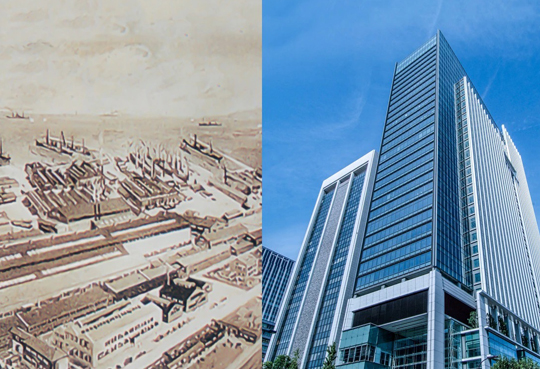The Founder
An ambitious young man named Yataro Iwasaki launched the first Mitsubishi company —a shipping firm—in 1870. Japan had just emerged from centuries of feudal isolation and was racing to catch up with the West. Yataro's business grew rapidly and diversified into a broad range of manufacturing and commerce. World War II brought an end to Mitsubishi as an integrated organization. But independent companies that trace their roots to the old Mitsubishi are active today in nearly every sector of industry.
Yataro Iwasaki was from the city of Kochi on the island of Shikoku, which was the home of the powerful Tosa clan. He worked for the clan and distinguished himself in managing its Osaka trading operations. In 1870, he set up his own shipping company, Tsukumo Shokai, with three steamships chartered from the clan. That was the beginning of Mitsubishi.
Origins of the famous emblem
The name of the new company changed to Mitsukawa Shokai in 1872 and to Mitsubishi Shokai in 1874. Yataro chose a corporate emblem that combined the three oak leaves of the Tosa crest and the three stacked diamonds of his family crest. That emblem is the source of the name, Mitsubishi, which means "three diamonds."
Yataro made a public display of patriotism in 1874, providing ships to carry Japanese troops to Taiwan. That earned the gratitude of the government, which rewarded him with 30 vessels. Yataro changed his company's name to Mitsubishi Mail Steamship in 1875, when it inherited the employees and facilities of a mail service disbanded by the government.
Rapid growth. Then adversity
Mitsubishi Mail Steamship inaugurated service to China and Russia and enjoyed a virtual monopoly on overseas routes. But the political winds shifted against Mitsubishi in the early 1880s, and the government sponsored the establishment of a competitor. The ensuing competition nearly bankrupted both companies.
Government intervention produced a temporary truce. But cutthroat competition resumed when Yataro died in 1885 and was succeeded by his brother Yanosuke. The feud ended with a government-arbitrated merger in 1885, which created Nippon Yusen--today's NYK Line.
Beyond Shipping
While competition was escalating on the sea, Mitsubishi was diversifying ashore. The company purchased the Yoshioka copper mine in Akita and Takashima coal mine in Nagasaki. It leased the Nagasaki Shipbuilding Yard from the government in 1884 and later engineered Japan's first domestically produced steel steamship there.
Mitsubishi continued to grow and diversify under the autocratic leadership of Yanosuke Iwasaki. He bought up more mines to provide resources for Mitsubishi and Japan's growing industries. And he dropped "Steamship" from the company name. He also paid the equivalent of approximately US$1 million for 80 acres of swampy marsh next to the Imperial Palace in 1890. Ridiculed at the time, Yanosuke's investment today is worth many billions of dollars.
Modern Management
Yataro's son, Hisaya, assumed the presidency in 1893. The University of Pennsylvania graduate restructured Mitsubishi to support increasingly diverse business operations. He set up divisions for banking, real estate, marketing, and administration, as well as for the original mining and shipbuilding businesses.
Some of Hisaya's private investments are part of today's Mitsubishi companies. He purchased the Kobe Paper Mill, which is today's Mitsubishi Paper Mills. And he backed the founding of Kirin Brewery. His cousin Toshiya founded Asahi Glass, Japan's first successful manufacturer of plate glass.
Mitsubishi management modernized further when Yanosuke's son Koyata succeeded Hisaya as president in 1916. Koyata, a graduate of Cambridge University, incorporated the divisions as semiautonomous companies. He steered Mitsubishi to leadership in such sectors as machinery, electrical equipment, and chemicals. The companies that later became Mitsubishi Heavy Industries developed automobiles, aircraft, tanks, and buses. And Mitsubishi Electric became a leader in electrical machinery and in home appliances.
Related Links
Let's Connect!
For customer emergencies, please contact our 24- hour Mitsubishi Electric Customer Care Center on: 8001282828
For general enquiries and to help us respond more efficiently, please provide your details below or contact our Head Office on: +966 92 001 2424
Send us a message
about/group_history




